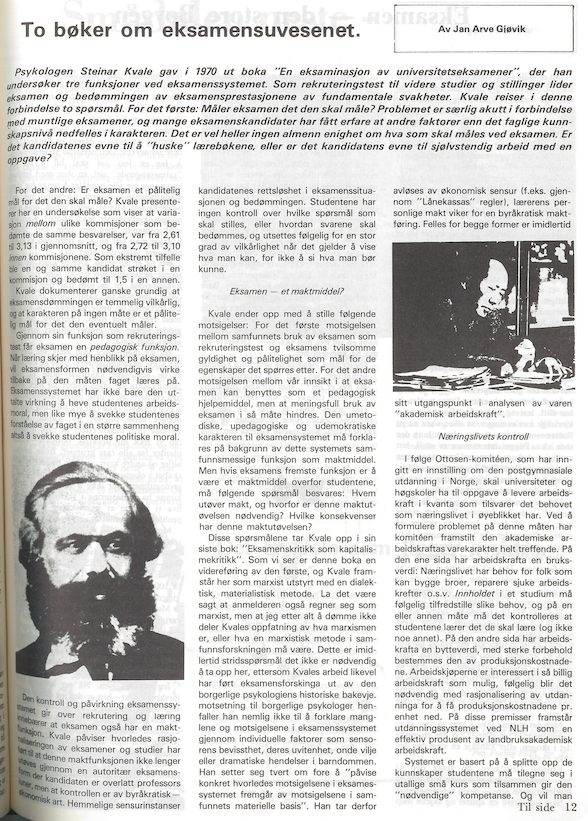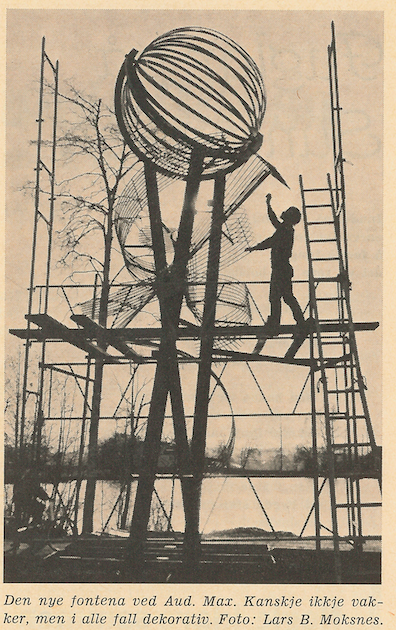Tuntreet Decade by Decade: The 70's

Tuntreet Decade by Decade: The 70’s
Tuntreet of the 70’s start with an editorial claiming that if conservation of nature isn’t taken seriously, mankind will be threatening its own existence. This is just one example of the drastic change of tone that lasts throughout the decade. The funny articles are now either toned down, or just simply gone. The outlook is broadened, and the subjects are more serious. How in the world could we have such a drastic change in such a short time?
Journalist: Tord Kristian F. Andersen
Translator: Aleksander Mæland Munkejord
Conservation of nature was no unfamiliar term, but it was in relation to the nature conservation year of 1970 that the discussions heated up. Perhaps not so strange, as this was the time when the discussion pages were appearing for real. The discussions about the EEC also made their mark on Tuntreet in the early 70’s. Something evident from the abovementioned is how nothing is really related to Ås. Tuntreet had now grown past its borders, and even if they still covered local affairs, it was not much compared to the larger subjects nationally and globally. The discussion pages would later grow on to form a separate appendix, that was released every two weeks. Here, we found everything from minor annoyances to serious political debate.
But it is not like they stopped covering what happened in Ås either. UKA went on as always. The organization had grown so vastly that in 1972 they had to take a stand on how it was supposed to function. The construction of Aud.Max. takes up a bit of space, both before and after it was finished in 1970. This was an important breath of fresh air, especially when the Samfunnet-building could hardly even be mentioned without talking about lack of space and plans of renovations. Pentagon got a major expansion, and the student village as we know it today took its shape. In the 70’s there was also talk about an airport in Ås, which had lots of people involved. Anti-car-ism and what to do with the traffic in the center of Ås was also covered from time to time.
The studines are rising in numbers, and how they play into the student life becomes an active part of the debate. In addition to the good old fraternities like Hankattene, PB and newer ones like Erotiske Selskab, we now get several all-new social clubs. Lærken was established in 1972, joined by Åsblæsten in ’74 and Flatlusa in ’79. Lærken takes up a lot of room from day one. A funny piece of curiosity is that Kurt Stille’s happened at Lillebrand the first years. We also see the world premiere of Tour de Kringla.
Despite the change of tone, it is still evident that Tuntreet has not forgotten itself. In an article about the Tuntre-office from 1971 you can read that “The Tuntre-office has more atmosphere per m3 space than any other office on campus”. (I do not disagree). In the office one could enjoy the cheapest beer of the school, accompanied by posters of Lenin, Castro, and Che Guevara. A column called “Climbing the old Tuntre” appears, resembling this column of my own, but in the shape of copy-pasted funny articles from editions 20 years back. Apparently, I am not alone in thinking that the ideal housewife was entertaining. The content had changed, but the community and the workflow were still mostly the same. This, however, was soon about to be challenged.
Approaching the mid-70’s, Tuntreet ends up in a complete existential crisis. Over time, it becomes more and more difficult to keep the magazine economically afloat, and at the same time people are confronting what role it plays for the students. Grete Refsum, elected editor in 1974, suddenly resigns from the position. In the next edition she submits a reader’s letter where, put briefly, she wishes for Tuntreet to be abolished and replaced by a wall newspaper. The magazine feels like a monopoly that should be democratized. There are claims of Tuntreet being read, thrown away, and not contributing to discussions. The editorial staff is painted as unmotivated, and lacking ideas. The oncoming editor, Egil Johansson, strongly disputes these claims in the next edition. This was obviously no easy time for the magazine, but Tuntreet still played an important role. When is the last time you saw a complete archive of “Dassavisa” (“The Toilet Paper”)?
Regarding Samfunnet, in the 70’s they began to elect boards on a political platform. Not only did they have party affiliations, but as an example they ran for elections with complete proposals for semester programs, which they presented before they were even elected. The debate between the board proposals were likely to happen on the beforementioned discussion pages, in addition to the “KF” (Confrontational Assembly), which worked as a roast of candidates before the GA. Samfunnet had earlier been a natural meeting place for students and lecturers, in a more informal environment. The brutal radicalization led to an alienation of the lecturers, who after a while stopped going to Samfunnet, never to return. The school had suddenly become a place for more than just the farmers’ sons, and one year the student mass increased by 50%. Students were to a growing extent coming from the cities, and brought with them totally new impulses. The agriculture had to be more environmentally friendly. The world had to be fed. All in the light of a hard left turn. Apparently, it was impossible to write an article about exams without including pictures of both Marx and Mao.
With everything that happened, I am not surprised that the magazine takes concrete steps to be more inclusive, not to mention educating. Themed pages are on the rise, and by the end of the decade we get the complete themed editions, diving deep into a specific subject. As time goes by, several articles are written in English. We even get an “English column”. On the less serious side, we get the “Hyppeplogen”. This is open for all kinds of poems, short stories, drawings, and other creative features.
All in all, the 70’s is an extremely important epoch in the history of Ås. This drastic change is reflected in and through Tuntreet, even though they try their best in being independent. “Under Dusken” was elected politically, just like our Board of Samfunnet. The magazine appears differently before and after this. The issues are tighter, with larger focus articles, and the content is broader. This trend turns around towards the 80’s and 90’s, but for the time being Tuntreet was in the middle of a gargantuan student-political engagement-mecca. It is after this we slowly begin to recognize the Tuntre of today, so stay tuned! Thanks to Lars Raaen, Halvor Holtestaul and Kjell Aksnes for contributions. Have a nice summer!






